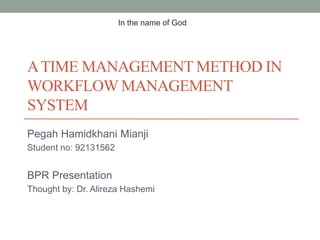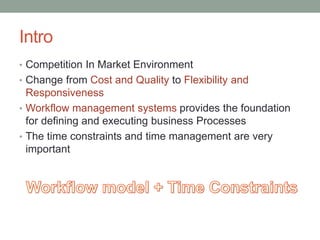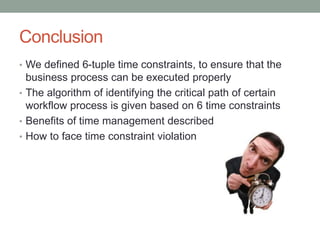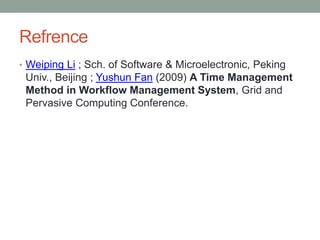92131562-Time Management Method(slides only)
- 1. ATIME MANAGEMENT METHOD IN WORKFLOW MANAGEMENT SYSTEM Pegah Hamidkhani Mianji Student no: 92131562 In the name of God BPR Presentation Thought by: Dr. Alireza Hashemi
- 2. Intro ŌĆó Competition In Market Environment ŌĆó Change from Cost and Quality to Flexibility and Responsiveness ŌĆó Workflow management systems provides the foundation for defining and executing business Processes ŌĆó The time constraints and time management are very important
- 3. Overview In this Presentation will see: ŌĆó 6 time constraints in workflow modeling ŌĆó Workflow routing and Control Condition ŌĆó Calculate critical Path in build time ŌĆó Forward Calculation ŌĆó Backward Calculation ŌĆó Calculate critical Path in run time ŌĆó Forward Calculation ŌĆó Backward Calculation ŌĆó A solution for uncertainty of execution time ŌĆó Conclusion
- 4. Workflow Model ŌĆó A collection of activities and dependencies among activities ŌĆó Some Model definition Tools: Petri Nets , XPDL ŌĆó Here we use directed graph: ŌĆó N: Activity ŌĆó C: Edge ŌĆó The activity is denoted by: ŌĆó D: I/O Data ŌĆó E: executor ŌĆó R: resource ŌĆó T: time constraint ŌĆó In this presentation we focus on time constraints
- 5. Timed constraints ŌĆó Time Duration: The time span from the activity is inactive state to completed => Compulsory ŌĆó Forced start time: Is the time that an activity should be executed after it ŌĆó Deadline: Is a time that an activity be completed ŌĆó Fixed Date Constraint: An activity can only be executed on certain fixed dates. For example: every Monday left bound of constraint right bound of constraint
- 6. Timed constraints ŌĆó Time Difference: the time difference between two activities is caused by different time zones ŌĆó Time Distance: the time duration between activity A1 and A2, where A1 is the predecessor of A2 We show them like : The Value of each time constraint, if exist, is assigned by the workflow designer according to the experience value in build time.
- 8. Iteration Time Duration ŌĆó Probability of iteration: p ŌĆó Total average execution time: T A2 A4 A1 A3
- 9. Workflow Critical path ŌĆó We use extended Critical Path Method (CPM) with time constraints considered : earliest start time of an activity : earliest finish time of an activity : latest start time of an activity : latest finish time of an activity Depending on control dependencies between activities in workflow these are calculated
- 10. Rules In Critical Path Computation ŌĆó Assume A and B are two adjacent activities and A is the predecessor of B ŌĆó ØÉĖØæĀ of B is ØÉĖØæĀ of A plus the time duration of A ŌĆó If some time distance required the ØÉĖØæĀ of B is: ŌĆó If they are in different time zones, the time difference must be taken into account ŌĆó If time zone B is in the working hours ŌĆó Or, time zone B is not in working hours
- 11. Rules In critical path computation ŌĆó If there is a fixed date constraint on activity B, we have two situations: ŌĆó If the time ØÉĖØæåØÉ┤ + ØæĪ ØÉ┤ is located in the space of the fix date ŌĆó else
- 12. Build Time Calculation Considerations ŌĆó Time constraints according to the experience or estimated value ŌĆó We treat all routing controls as AND-Split / AND-Join ŌĆó The forced start time, deadline and time difference canŌĆÖt be identified because workflow is static
- 13. Build Time Calculation (Forward)
- 14. Build Time Calculation (Backward)
- 15. Runtime Calculation Considerations ŌĆó Start time is real and the time information of all the other Activities can be Identified ŌĆó All six time constraints should be taken into account ŌĆó All OR-Split/ OR-Join pair will be checked ŌĆó So a new graph is given for calculation ŌĆó ØæĪ ØæżØææ (for time difference constraint) and ØæĪ ØæżØæō (for fixed date constraint) can be figured out exactly
- 20. Benefits Of Time Management ŌĆó After Identifying the critical path of a workflow process we can benefit from it ŌĆó Workflow designers: ŌĆó Find bottlenecks and try to optimize the process ŌĆó Find any potential time constraint conflict and resolve error ŌĆó Workflow managers: ŌĆó Adjust the time plan according to time constraints ŌĆó Schedule the activities in the work in the work list to enhance the throughput ŌĆó Monitor the execution and be alerted about potential time error ŌĆó Adjust the execution of workflow instance if any time constraint is violated
- 21. Time Constraint Violation Deadline violation: the activity canŌĆÖt be complete before itŌĆÖs deadline Four methods to overcome ŌĆó Adjust the time durations of activities that are under scheduling ŌĆó Try to postpone the deadline of the very activity that will be violated ŌĆó Try to find another path to replace current path ŌĆó If the former 3 methods canŌĆÖt work the system will arouse time exception and use exception handling Forced start time error: system has to wait for certain time
- 22. Uncertainty of execution Time ŌĆó We previously used experience or previous estimation but this approach is very static ŌĆó Estimate at process instantiation based on ŌĆó Executer ŌĆó Instance ŌĆó Try to calculate the time extracted from history data or logs of existing WFMSs ŌĆó If no log exist get the time from who take charge of the related job l=
- 23. Conclusion ŌĆó We defined 6-tuple time constraints, to ensure that the business process can be executed properly ŌĆó The algorithm of identifying the critical path of certain workflow process is given based on 6 time constraints ŌĆó Benefits of time management described ŌĆó How to face time constraint violation
- 24. Refrence ŌĆó Weiping Li ; Sch. of Software & Microelectronic, Peking Univ., Beijing ; Yushun Fan (2009) A Time Management Method in Workflow Management System, Grid and Pervasive Computing Conference.

























